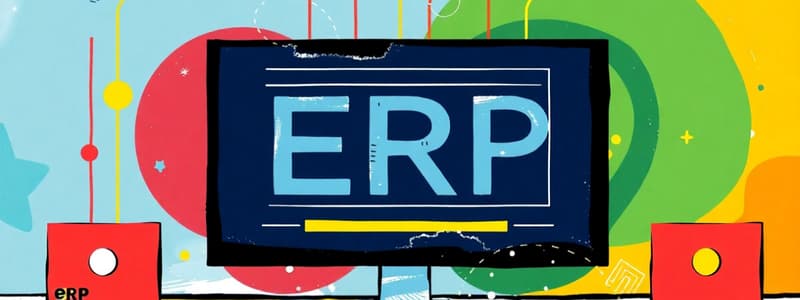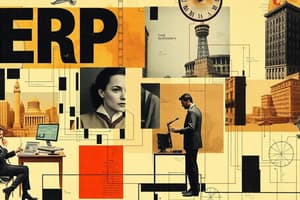Podcast
Questions and Answers
What is a benefit of automating attendance and labor tracking systems for employees?
What is a benefit of automating attendance and labor tracking systems for employees?
- Creates unnecessary complexity in reporting
- Minimizes control over staffing adjustments
- Increases dependency on manual processes
- Reduces time spent on record management (correct)
Which company is mentioned as having selected Kronos Inc. software for time and labor management?
Which company is mentioned as having selected Kronos Inc. software for time and labor management?
- SAP Corporation
- Smurfit-Stone Container Corp
- PeopleSoft Inc.
- Banner Health (correct)
What functionality do HR modules in ERP systems provide?
What functionality do HR modules in ERP systems provide?
- Discontinued records management
- Standalone payroll processing
- Manual attendance logging
- Integrated operational and strategic level controls (correct)
How does the use of Workbrain Inc.’s ERM3 software benefit employee scheduling?
How does the use of Workbrain Inc.’s ERM3 software benefit employee scheduling?
What is a common issue with manual tracking of employee data?
What is a common issue with manual tracking of employee data?
Which of the following is NOT a problem faced in human resources according to the provided information?
Which of the following is NOT a problem faced in human resources according to the provided information?
What is one of the significant benefits of integrating HR systems with ERP?
What is one of the significant benefits of integrating HR systems with ERP?
Which HR module allows employees to make changes to their personal data?
Which HR module allows employees to make changes to their personal data?
Which of the following attributes of HR modules allows for tracking the safety and compliance of employee records?
Which of the following attributes of HR modules allows for tracking the safety and compliance of employee records?
What is a focus of operational level controls in HR management.
What is a focus of operational level controls in HR management.
What is a key feature of HR modules that enhances their functionality?
What is a key feature of HR modules that enhances their functionality?
Which type of HR information enables the tracking and analysis of a company's workforce?
Which type of HR information enables the tracking and analysis of a company's workforce?
Which of the following is a challenge in managing compensation packages mentioned?
Which of the following is a challenge in managing compensation packages mentioned?
Which of the following functionalities is NOT typically included in an HR management module?
Which of the following functionalities is NOT typically included in an HR management module?
What aspect does not contribute to the scalability and flexibility of HR modules?
What aspect does not contribute to the scalability and flexibility of HR modules?
The integration of HR systems with ERP leads to redundancy in employee data.
The integration of HR systems with ERP leads to redundancy in employee data.
Human capital inventory is a tool used for tracking employees at the operational level.
Human capital inventory is a tool used for tracking employees at the operational level.
HR modules in ERP systems do not provide capabilities for employee self-service.
HR modules in ERP systems do not provide capabilities for employee self-service.
The management of diverse workforce is supported by HR information and reporting tools.
The management of diverse workforce is supported by HR information and reporting tools.
The primary focus of governmental reporting in HR systems is on training and applicant selection.
The primary focus of governmental reporting in HR systems is on training and applicant selection.
Automating attendance tracking can reduce the time consumed by manual processes.
Automating attendance tracking can reduce the time consumed by manual processes.
Banner Health selected Workbrain Inc. software for time management.
Banner Health selected Workbrain Inc. software for time management.
HR modules in ERP systems provide benefits administration and payroll management.
HR modules in ERP systems provide benefits administration and payroll management.
Manual tracking of employee records is often comprehensive and integrated.
Manual tracking of employee records is often comprehensive and integrated.
ERP systems are known for being inflexible and difficult to scale.
ERP systems are known for being inflexible and difficult to scale.
Flashcards
Automated Employee Tracking Benefits
Automated Employee Tracking Benefits
Automating employee tracking reduces manual processes, making them less time-consuming and error-prone. This leads to better analysis and more control over employee data.
Real-time Employee Data Access
Real-time Employee Data Access
Software like Kronos allows for immediate access to employee data through web, phone, or badge terminals which facilitates quick staffing adjustments.
ERP HR Modules
ERP HR Modules
Enterprise Resource Planning (ERP) systems include modules for managing employee records, benefits, and payroll.
Employee Relationship Management (ERM)
Employee Relationship Management (ERM)
Signup and view all the flashcards
Scalable and Flexible ERP Systems
Scalable and Flexible ERP Systems
Signup and view all the flashcards
HR Problems
HR Problems
Signup and view all the flashcards
HR Systems Evolution
HR Systems Evolution
Signup and view all the flashcards
ERP HR Module Features
ERP HR Module Features
Signup and view all the flashcards
Benefits Administration
Benefits Administration
Signup and view all the flashcards
Payroll
Payroll
Signup and view all the flashcards
Time and labor management
Time and labor management
Signup and view all the flashcards
Employee Self-Service
Employee Self-Service
Signup and view all the flashcards
Management Control Modules
Management Control Modules
Signup and view all the flashcards
Integrated Database
Integrated Database
Signup and view all the flashcards
Benefits of Automating Employee Tracking
Benefits of Automating Employee Tracking
Signup and view all the flashcards
What does ERP stand for?
What does ERP stand for?
Signup and view all the flashcards
What are ERP HR modules?
What are ERP HR modules?
Signup and view all the flashcards
Scalability and Flexibility of ERP Systems
Scalability and Flexibility of ERP Systems
Signup and view all the flashcards
Integrated Operational and Strategic Controls
Integrated Operational and Strategic Controls
Signup and view all the flashcards
What are the limitations of standalone HR systems?
What are the limitations of standalone HR systems?
Signup and view all the flashcards
What are the key benefits of ERP HR modules?
What are the key benefits of ERP HR modules?
Signup and view all the flashcards
What are the advantages of a common database?
What are the advantages of a common database?
Signup and view all the flashcards
Explain the concept of 'drill-down capability' in ERP HR modules.
Explain the concept of 'drill-down capability' in ERP HR modules.
Signup and view all the flashcards
How does workflow management enhance HR processes?
How does workflow management enhance HR processes?
Signup and view all the flashcards
Study Notes
Chapter 7: ERP Systems: Human Resources
- ERP systems support human resource (HR) processes
- ERP systems provide interrelationships among business processes, which support human resource management
- Case study: Atlantic Manufacturing—difficulties with recruitment, training, and retention of sales force; inadequate HR records; increasing HR paperwork and compliance requirements; difficulty managing compensation packages; needing a strategy to control employee benefit costs.
- Key Human Resource Problems: accurate employee information maintenance, job analysis and design, applicant selection, compensation, benefit administration, training, and governmental reporting
- Evolution of HR Systems: traditionally relied on stand-alone systems (specialized applications for applicant tracking, compensation, benefits, and attendance); however, these often had redundant data and no connection to financial systems; ERP systems are linked to financial systems and follow "best practices"
- ERP HR Modules: components include HR management (personnel records, resumes), benefits administration (links employee data to actual benefits, allows selection from group of benefits), payroll (paychecks, tax reports, accounting data), time and labor management (employee/manager self service, travel reimbursement), and training class data and benefits changes.
- HR Modules Attributes: integration (common database, audit trails), scalability and flexibility (drill-down capability), workflow management (electronic routing of documents and other document management), process standardization, security, and user-friendly web accessibility.
- Table 7–4: Human Resource Decisions Supported by an ERP System: examines questions and decisions associated with recruiting, job analysis, compensation, benefits, and workforce development. Questions address internal candidates, effective recruiting sources, managerial characteristics, job turnover, skill sets, compensation packages, market surveys, controlling employee benefits and self-selection, replacement personnel, future workforce needs, workforce training needs, and the impact of mergers on workforce development.
- Management Control Modules: HR information enables management of a diverse workforce, supports managerial decisions, provides operational level controls (maintain and update employee files, job analyses, design files, regulatory files, skills inventory files), and strategic level controls (human capital inventory, position control, budgeting, labor/management relationships, business intelligence tools, predicting trends
- Featured Article: Keep Track of Your Employees: addresses benefits of automated time and attendance records, and advantages for employees using these systems. Also discusses the manual processes in most companies and the improvements automation brings.
- Specific Software Examples: Banner Health and Smurfit-Stone Container Corp use ERP software solutions for time and attendance, payroll processing, employee relationship management, etc.
- Summary: ERP systems incorporate HR modules for record management, benefits administration, and payroll, offering integrated operational and strategic level controls; systems are scalable and flexible.
Studying That Suits You
Use AI to generate personalized quizzes and flashcards to suit your learning preferences.




